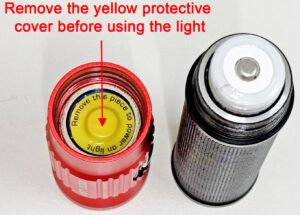Technical Updates for Sea Dragon Mini Lights
If the Sea Dragon Mini light is not powering on, please follow these troubleshooting steps:
- If your Sea Dragon Mini light includes an 18650 Li-ion rechargeable battery, make sure to remove the yellow protective cover from the battery. The battery would be pre-installed in the light with the protective cover to prevent the light from accidentally powering on. The protective cover may use a glue dot to keep it attached to the battery. Some of the glue residue may stick to the battery preventing it from making a good electrical contact.

- Thoroughly clean the electrical contacts between the battery grip and light head using a cloth or swab moistened with isopropyl alcohol.

- Make sure the battery is fully charged. Try using another battery. Only using an 18650 battery button-top type 18650 battery that has integrated protective circuitry, and minimum of 2600mAh/3.5A discharge current. Do not use a flat-top type 18650 battery.
- Inspect inside the battery compartment and inside the light head for water damage. Contact your local authorized SeaLife dealer or distributor in your country for repair service.
Do not use CR123 batteries. Sea Dragon Mini lights are not designed to function with this type of battery. Only use an 18650 battery button-top type 18650 battery that has integrated protective circuitry, and minimum of 2600mAh/3.5A discharge current. Do not use a flat-top type 18650 battery.
Not all 18650 batteries are the same. SeaLife recommends using a quality 18650 Li-ion batteries from reputable brand. Make sure the 18650 battery you choose meets all the following requirements:
- Button-top type battery – not flat-top
- Integrated protected circuitry
- Minimum mAh rating of 2600
- Minimum discharge current of 3.5A
Warning: Never use a damaged 18650 battery! Replace the battery if its sleeve/wrapper is cut, torn damaged in any way. The external sleeve helps to prevent short circuiting of the battery. Short circuiting occurs if a metal object makes contact with the + and – end of the battery at the same time, which may result in the battery overheating and may result in fire or explosion.
